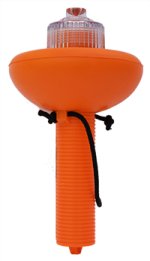Using aerial signals.
Aerial flares should be fired after sighting or hearing a potential rescue vessel. To attract attention to your distress situation, the U.S. Coast Guard recommends that you fire two aerial flares – one immediately after the other – so rescuers can confirm the sighting and the direction of the signal.
Parachute flares do not need to be fired in two’s, since a single parachute flare has an adequate burn time (25 to 30 seconds) to confirm sighting and position.
Using hand-held signal flares.
Orion hand-held signal flares are intended as homing signals to pinpoint your position. The surface-to-surface sighting range on water is approximately 3 to 5 miles, depending on boat elevation. If a rescuer is 5 miles away and running at 20 miles per hour, it will take 15 minutes to reach you. Therefore, you should have at least 12 minutes (total burn time) of signals onboard to maintain a strong homing signal until help arrives.
When should I signal?
Orion aerial flares and other "one-time" signals should be fired only after sighting or hearing a potential rescuer. Experts recommend that once an aircraft has been sighted, one flare should be fired … then a second flare fired immediately after the first one to let search teams confirm the sighting and direction of the signal.
Remember, search and rescue missions often establish grid search patterns, which means you may see the same aircraft two or three times coming from different directions. Do not waste aerial flares if the aircraft has initially passed by you. Carrying extra pyrotechnic signals onboard will improve your chances of being sighted.



